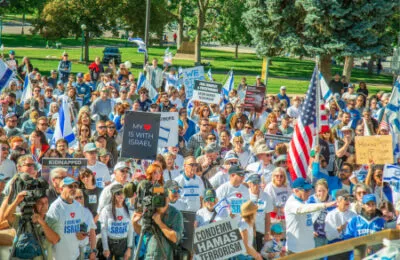SOMETHING real, but not concrete.
It went like this.
Jacob M. Charlop, later known as a great man, found himself somewhat ill when he was 19. Doctors advised that he spend a few days bathing in the Mediterranean Sea. So he descended from Jerusalem to Jaffa. The year was around 1905.
The time was a few days before Shavuot, the holiday which is real, but without concrete ritual props.
On Shavuot, the young Charlop entered the local shul it must have been small; this was long before the great Jewish growth in Israel and he spent the night there studying Torah.
He was quite the budding scholar.
But no matter how talented, every Torah scholar needs a mentor. The tradition of receiving the tradition from a mentor goes back to G-ds speech to Moses and Moses speech to Joshua.
Suddenly, in the early morning light, it was time in the small shul for the reading of the Torah.
On Shavuot, an Aramaic poem, Akdamus, is recited before the reading of the Torah.
It is recited only once yearly.
Recited when one is too physically exhausted (at the end of an entire night of study) to perceive anything but the essence.
On that early Shavuot morning Rabbi Abraham Isaac Kuk recited the Akdamus with, apparently, such spiritual power that young Charlop said to himself:
My soul is bound to Rabbi Kuks, for the rest of my life.
So it was that the young man who became a great rabbi became the prime disciple of Rabbi Kuk.
A lifelong relationship was established.
They had not yet exchanged a word.
Shavuot . . . something real, but not concrete.
SHAVUOT is different.
Misunderstood.
Set aside.
Skipped.
Amorphous, hard to grasp.
For Shavuot there is no box score, balance sheet, bank statement, grade point average no definitive take.
Shavuot is unlike all other Jewish holidays.
It is unlike Shabbat, which is comprised of rituals and restrictions that liberate. Shabbat can be grasped.
It is unlike Rosh Hashanah or Yom Kippur, which one may approach without having spiritually prepared. One can always undergo a major reorientation at the last minute. The shock of a death, a major financial loss, a major illness or injury or simply the prospect of Rosh Hashanah itself can force one into deep introspection and life change. A last minute grasp is possible. Rosh Hashanah can be grasped.
Shavuot is also unlike Sukkot, which one may approach without having spiritually prepared because there is so much physical beauty to the holiday. The sukkah surrounds you. The lulav and etrog look intriguing and exude an uplifting scent. The time period after the somber High Holidays is intrinsically uplifting. Sukkot can be grasped.
Shavuot is unlike Passover because Passover is grasped via a plethora of rituals: putting away bread in favor of matzah; acquiring wine, bitter herbs and many other items for the seder and the holiday. Passover is anything but amorphous.
Unlike Shavuot.
SHAVUOT is mysterious.
Shimmering.
Communicative.
Powerful but imperceptibly powerful, like the timbre and depth of the great rabbis voice in the ears of the receptive student in Jaffa.
What is the secret of Shavuot?
Why is Shavuot so difficult to grasp?
To define?
To find meaningful?
To regard as important as Rosh Hashanah, Sukkot, Passover?
An answer:
Shavuot celebrates the giving of the Torah. If one does not delve into the Torah, its meaning is meaningless. One may approach many Jewish holidays at the last minute. Not Shavuot. One must live with the Torah, breathe it, find joy in it, be troubled by its sometimes seemingly inaccessible teachings. One must occupy oneself with the Torah, struggle with it, let it color ones mind and soul, in order to grasp it.
One must welcome the discipline it demands.
Shavuot is a 365-day moment, allowing for no contraction. Shavuot cannot be grasped via a last minute decision, scent or ritual, since no ritual can supplant a 365-day mental- spiritual process.
Denver has a yeshiva, in which Torah is studied; day schools, in which Torah is taught; a kollel, in which Torah is researched; synagogue classes and outreach lectures, in which Torah is conveyed; scholars, to whom questions about Torah may be addressed; Torah study partners (havrutot), people whose relationship embraces yet transcends friendship; individuals who make the study of Torah their primary purpose, if not necessarily their professional occupation. Something is spreading in Denver the study of Torah.
Such is the opportunity to penetrate the mystery of Shavuot, to climb on the 365-day conveyor belt that brings meaning to Shavuot, that gives depth to the celebration of the giving of the Torah.
In the desert.
Where the Jewish people, alone with G-d, found their destiny.
At the mount of Sinai.
On the sixth of Sivan.
On Shavuot.
In the early morning light.
Setting the Jewish people on their historical destiny, to bring the ethics and the holiness of Torah to the world, to bring the joy of Torah study to themselves.
To bind their soul to His.
Forever.











